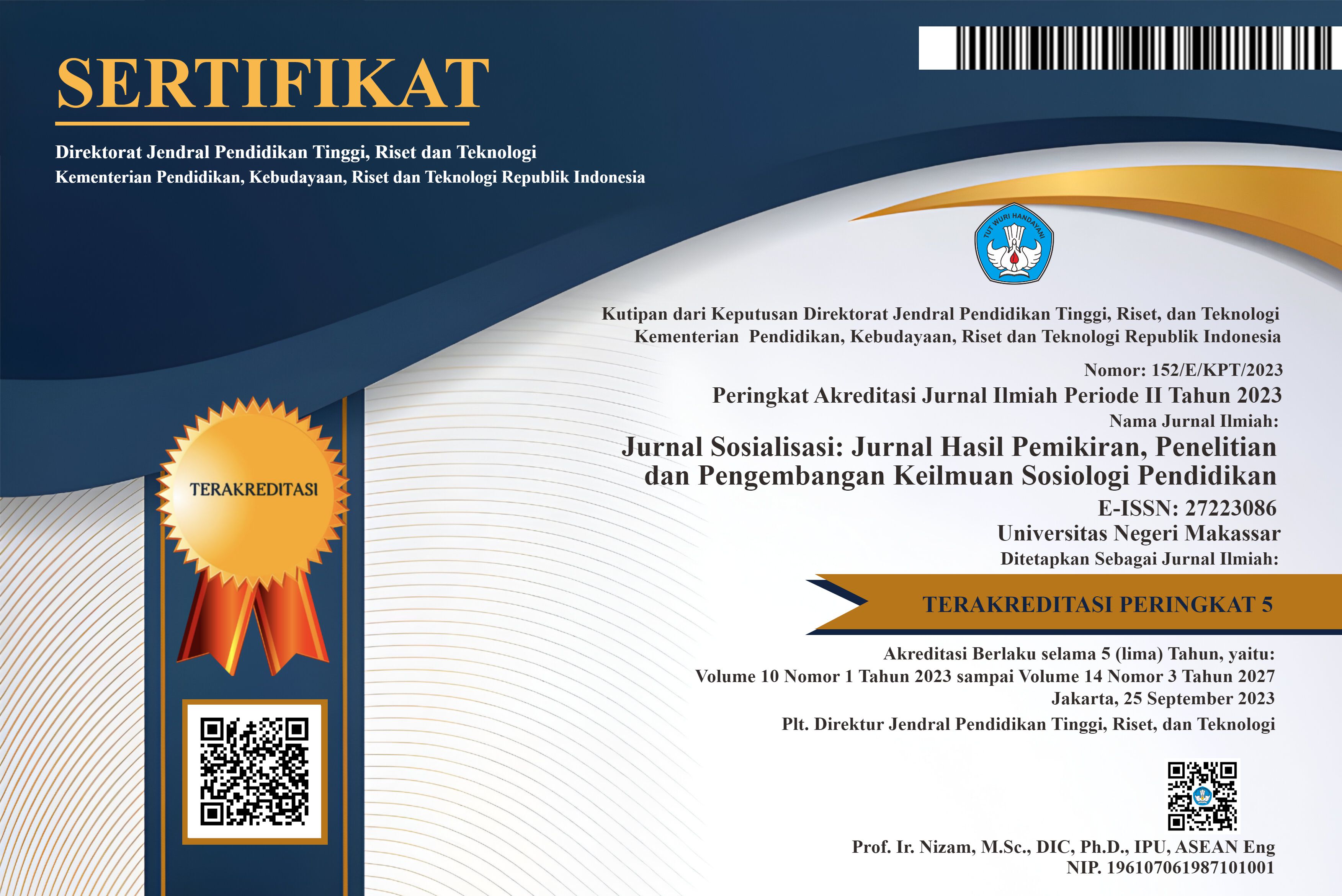Hubungan Empati dengan Intensitas Perilaku Merokok di Tempat Umum
(1) Fakultas Psikologi, Universitas Negeri Makassar, Indonesia
(2) Fakultas Psikologi, Universitas Negeri Makassar, Indonesia
(3) Fakultas Psikologi, Universitas Negeri Makassar, Indonesia
(*) Corresponding Author
DOI: https://doi.org/10.26858/sosialisasi.v1i1.23224
Abstract
Smoking is a bad habit that can have a negative impact on health, both for smokers and other individuals who are around them or passive smokers. This study aims to explore the relationship between the level of empathy possessed by smokers and the intensity of smoking behavior carried out in public places. The subjects in this study were 349 students in Makassar City. This study uses a quantitative approach, which is carried out by collecting responses from participants using research instruments in the form of smoking behavior questionnaires and empathy scales. Research data from respondents were analyzed using the Pearson Product Moment correlation test. The results of the analysis of the data collected showed a correlation coefficient value of -0.232 and a significance value of 0.000 (p <0.05). These results indicate that there is a significant relationship between empathy and the intensity of smoking behavior in public places in students in Makassar. The higher the empathy possessed by students, the lower the intensity of students to smoke in public places.
Keywords
Full Text:
PDFReferences
Almaidah, F., Khairunnisa, S., Sari, I. P., Chrisna, C. D., Firdaus, A., Kamiliya, Z. H., … Nurhasanah, K. (2021). Survei Faktor Penyebab Perokok Remaja Mempertahankan Perilaku Merokok. Jurnal Farmasi Komunitas, 8(1), 20–26.
Batson, C., Duncan, B., Ackerman, P., Buckley, T., & Birch, K. (1981). Is Empathic Emotion a Source of Altruistic Motivation. Journal of Personality and Social Psychology, 40, 290–302.
Cao, S., Yang, C., Gan, Y., & Lu, Z. (2015). The Health Effects of Passive Smoking: An Overview of Systematic Reviews Based on Observational Epidemiological Evidence. PloS One, 10(10), e0139907–e0139907. https://doi.org/10.1371/journal.pone.0139907
Davis, M. (1980). A Multidimensional Approach to Individual Differences in Empathy. JSAS Catalog Sel. Doc. Psychol., 10.
Djutaharta, T., Hendratno, K., & Adioetomo, S. M. (2005). Cigarette consumption, taxation, and household income: Indonesia case study.
Efendi, F., Aidah, F., Mh, E., Lindayani, L., & Reisenhofer, S. (2019). Determinants of smoking behavior among young males in rural Indonesia. International Journal of Adolescent Medicine and Health. https://doi.org/10.1515/ijamh-2019-0040
Khursid, F., & Anshari, U. (2012). Causes of Smoking Habit Among The Teenagers. INTERDISCIPLINARY JOURNAL OF CONTEMPORARY RESEARCH IN BUSINESS, 3, 848–855. Retrieved from https://journal-archieves14.webs.com/848-855.pdf
Knafo, A., & Uzefovsky, F. (2013). Variation in empathy: The interplay of genetic and environmental factors.
Kring, A., Johnson, S., & Davison, G. C. (2012). Abnormal Psychology, 12th Edition. Retrieved from https://books.google.co.id/books?id=YfcbAAAAQBAJ
Madani, M. A. (2018). Komunitas Kretek Minta Ruangan Khusus untuk Merokok. Retrieved March 3, 2021, from https://www.republika.co.id/berita/p3dawi283/komunitas-kretek-minta-ruangan-khusus-untuk-merokok
Mcdonald, N., & Messinger, D. (2011). The Development of Empathy: How, When, and Why. Moral Behavior and Free Will: A Neurobiological and Philosophical Approach.
Menteri Kesehatan dan Menteri Dalam Negeri. Kawasan Tanpa Rokok (KTR). , Pub. L. No. 7 Pasal 3, 1 (2011).
Naeem, Z. (2015). Second-hand smoke - ignored implications. International Journal of Health Sciences, 9(2), V–VI. https://doi.org/10.12816/0024103
Ng, M., Freeman, M. K., Fleming, T. D., Robinson, M., Dwyer-Lindgren, L., Thomson, B., … Gakidou, E. (2014). Smoking prevalence and cigarette consumption in 187 countries, 1980-2012. JAMA, 311(2), 183–192. https://doi.org/10.1001/jama.2013.284692
Posick, C. (2013). The role of empathy in crime, policing, and justice. Scholars Strategy Network.
Pribadi, B. (2013). Masih Banyak Perokok di Rumah Sakit. Retrieved January 1, 2021, from Republika website: https://www.republika.co.id/berita/nasional/umum/13/05/30/mnle0d-masih-banyak-perokok-di-rumah-sakit
Sari, A. T. O., Ramdhani, N., & Eliza, M. (2003). Empati dan perilaku merokok di tempat umum. Jurnal Psikologi, 30(2), 81–90.
Sumarna, R. (2009). Pengetahuan, sikap, dan perilaku merokok pada mahasiswa Fakultas Ilmu Sosial dan Ilmu Politik Universitas Indonesia (Universitas Indonesia). Retrieved from http://lib.ui.ac.id/file?file=digital/126586-S-5665-Pengetahuan, sikap-HA.pdf
Taufik, T. (2012). Empati Pendekatan Psikologi Sosial. In RajaGrafindo Persada. Jakarta: RajaGrafindo Persada.
Villadangos, M., Errasti, J., Amigo, I., Jolliffe, D., & García-Cueto, E. (2016). Characteristics of Empathy in young people measured by the Spanish validation of the Basic Empathy Scale. Psicothema, 28(3), 323–329. https://doi.org/10.7334/psicothema2016.6
West, R. (2017). Tobacco smoking: Health impact, prevalence, correlates and interventions. Psychology & Health, 32(8), 1018–1036. https://doi.org/10.1080/08870446.2017.1325890
WHO. (2015). Global Youth Tobacco Survey (GYTS): Indonesia report 2014. Who-Searo, 24. Retrieved from http://www.searo.who.int/tobacco/data/ino_rtc_reports/en/%5Cnhttp://www.searo.who.int/tobacco/documents/ino_gyts_report_2014.pdf
World Health Organization. (2014). Brief profile on tobacco health warnings in the South-East Asia Region. Retrieved from https://apps.who.int/iris/handle/10665/204827
Article Metrics
Abstract view : 311 times | PDF view : 147 timesRefbacks
- There are currently no refbacks.

This work is licensed under a Creative Commons Attribution 4.0 International License.


































